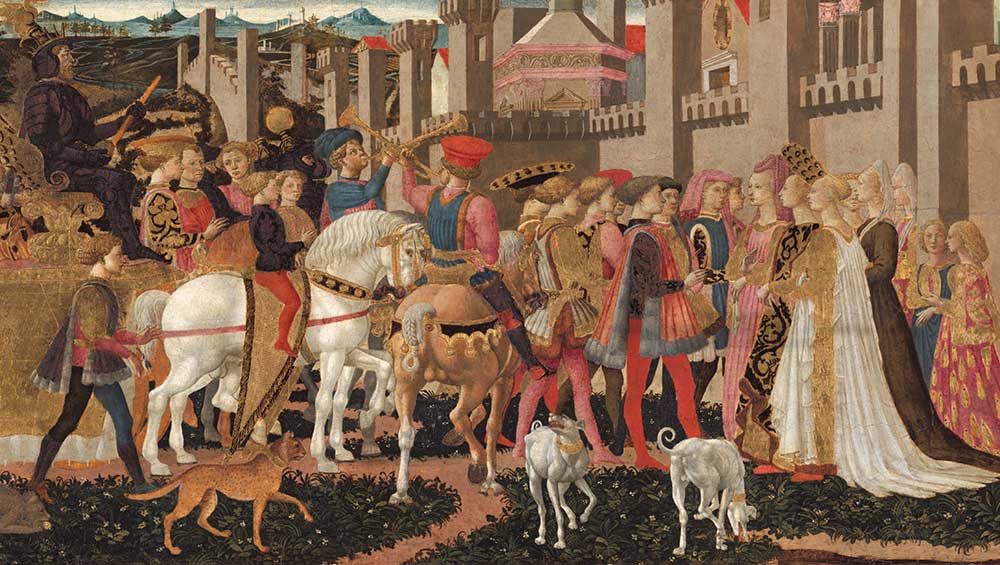
Francesco Pesellino. The Triumph of David, c1445-55. Tempera on wood, 43.3 × 177 cm. Bought with the assistance of the Art Fund and a number of gifts in wills, 2000. © The National Gallery, London.
The National Gallery, London
7 December 2023 – 10 March 2024
by TOM DENMAN
Her nimbed head is framed by a marble scallop shell niche blotchy with out-of-focus, white, black and orange veins that dance behind her to offset her stillness and intention. She sits, her lap draped ultramarine, at a slight diagonal to the white ledge jutting in at the bottom right corner of Francesco Pesellino’s Virgin and Child (c1455). On this meagre and yet fundamental component, whose material is hard to identify but easy to imagine as stone, stands her son. He is supported or held, or at least handled by his mother, in a helix of limbs, fingers and baby flesh. His podgy contrapposto swings his hips towards her while bending his torso away; his hands, which continue, spiralling inwardly, the pattern of his mother’s, are almost but not quite clasped, just as his right index finger and thumb are almost but not quite touching. The almost-touches recur in the gap between her middle finger and his cheek, in what is an all but impossible rendering of pictorial depth hidden from view. Is she tapping? Keeping some kind of time? Hovering between the tangible and intangible, absence and presence, they are moments that seem to refer to something beyond our grasp or too precious to be depicted. In us, their effect is pneumatic: they elicit a slowing of the breath.
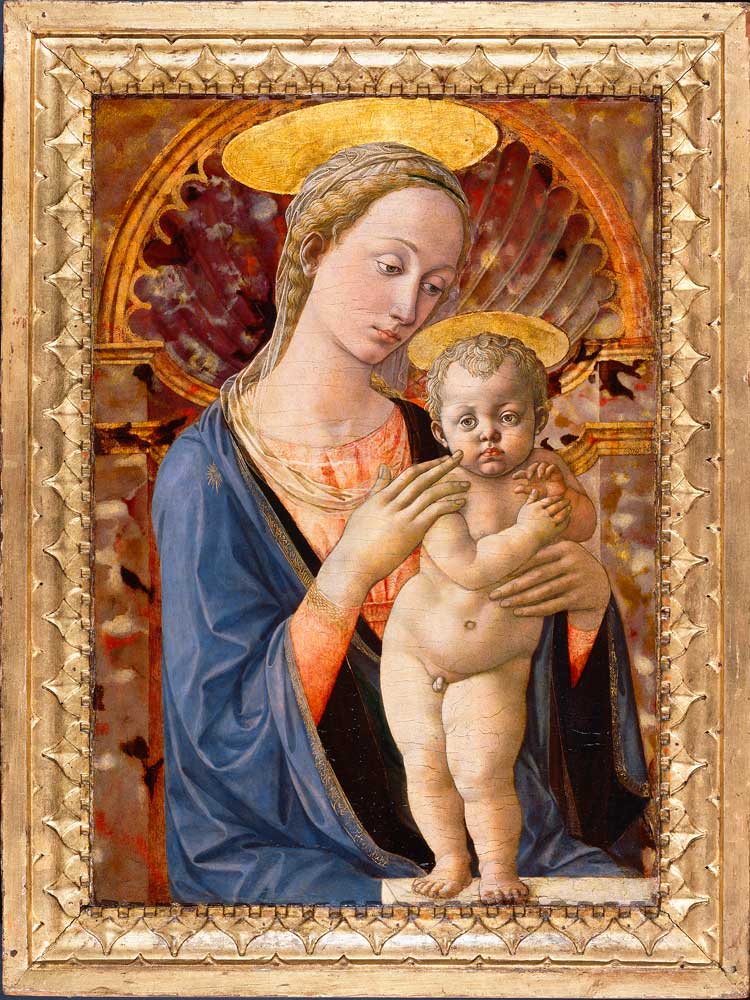
Francesco Pesellino. Madonna and Child, c1450. Tempera and gold on wood, 78.5 x 59 cm. Lyon, Musée des Beaux Arts. © Lyon MBA - Photo Alain Basset.
Francesco di Stefano was born in Florence in about 1422. His father died when he was young, and he moved in with his grandfather, Giuliano d’Arrigo di Gioccolo Giochi, a painter known as “Pesello”, meaning “the Pea”, who specialised in the banners and other ephemera used in public festivals and processions (given the disposable nature of such work, no examples survive). That his grandfather’s nickname, then as now, is also Italian slang for the male member did not deter Francesco from adopting its diminutive, “Pesellino”, “Little Pea”, for himself. Indeed, declaring such professional lineage may have assisted his rapid rise to fame. He became employed, like his grandfather before him, by the prosperous Medici family as it gained dominance in the Florentine republic. Sadly, his career was cut short at its peak by his early death in 1457. Six centuries down the line, this is Pesellino’s first monographic exhibition.
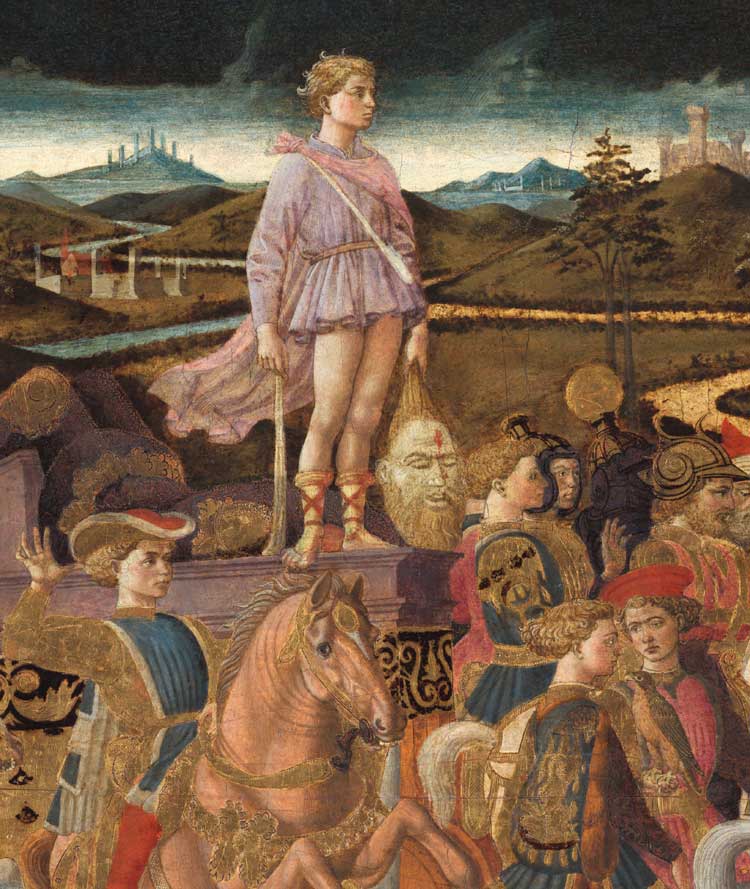
Francesco Pesellino. The Triumph of David, c1445-55. Tempera on wood, 43.3 × 177 cm. © The National Gallery, London.
Pesellino mastered a specific kind of touch, mimicked, it seems, in the sensitive tactility of his Virgin and Child; it is a sign of this composition’s success that, down to its touches and almost-touches, it was much imitated by his contemporaries. The Renaissance term disegno, which translates as “design” or “drawing” but conceptually encompasses the creative impulse capable of animating all the “fine” arts, does not quite do Pesellino’s touch justice. It is disegno, certainly, but of a particular kind that issues from the fingertips; to verbalise it is to speak with the tip of one’s tongue. His lines are like filigrees; the whole – whether the configuration of bodies in the David panels (both c1445-55) or the diminishing landscape backgrounding the Pistoia Altarpiece (1455-60) – is often articulated through multiplying minutiae, which provide fascination without distracting us from the all-important narrative. Indeed, they tune our attention to it, as if singing its song. Arguably, this is more the case for Pesellino than for his Florentine peers, such as the generally more corporal and architectural Benozzo Gozzoli or Andrea del Castagno.
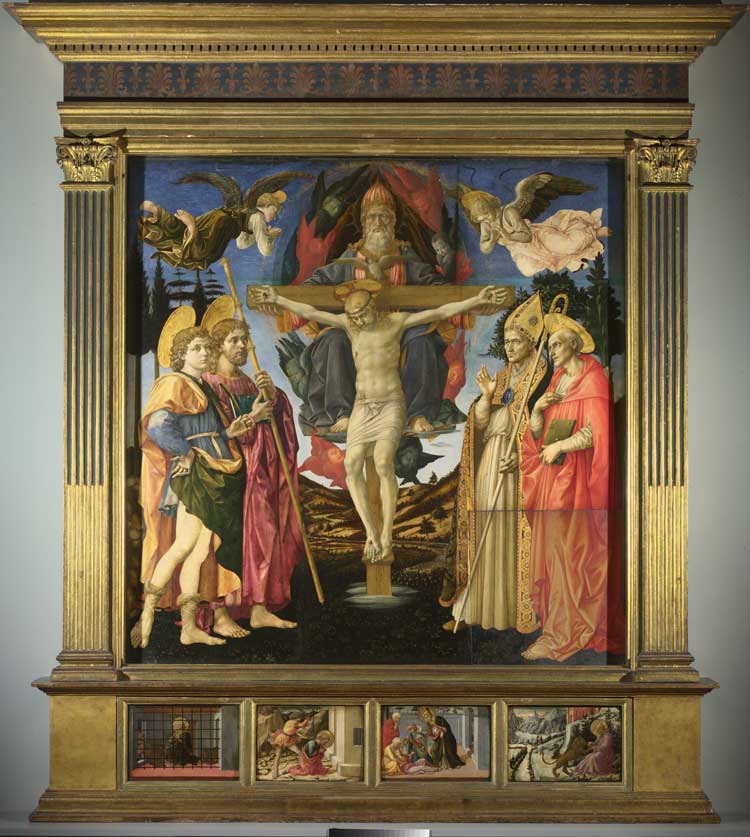
Francesco Pesellino, Fra Filippo Lippo and Workshop. The Pistoia Santa Trinità Altarpiece, 1455-60. Egg tempera, tempera grassa and oil on wood. © The National Gallery, London. Royal Collection Trust / © His Majesty King Charles III 2022.
The centrepiece of this small, single-room show is a pair of panels depicting David’s victory over Goliath and triumphant parade (both c1445-55). These were originally either the fronts of cassone, large chests containing a bride and groom’s wedding trousseau, or spalliere, panels inserted “at shoulder height” into the wainscotting of a bedchamber. Here, the artist could easily be channelling the fanfare and the noise of the festivals and pageants for which his grandfather provided banners and their orderly-chaotic stimuli. A similar thing might be said of the aqueous procession in King Melchior Sailing to the Holy Land (c1445-50), a lively concatenation of boats, sailors, well-wishers, rocks, mountains and cities revolving around the central ship’s mast.
In the first of the David panels, the nonlinear narrative sequence, keeps the eye moving back and forth, imbibing detail: the lions from which David protects his livestock, David’s knee propped on Goliath’s shoulder as he saws off his head; lots of impossibly complex entanglements of crisscrossing horse and human legs and buttocks, a windy path leading the eye to the skirmishes and city walls and tower-topped hills in the background. As we delight in the artist’s technical virtuosity – and David’s all-too-real look of calm, confident goodness – one crucial narratival effect of this broken linearity is to remind us, again and again, of the deadlock between Israelites and Philistines that David must resolve, and which he does; hence the contrast made by the linear sweep in the neighbouring panel.
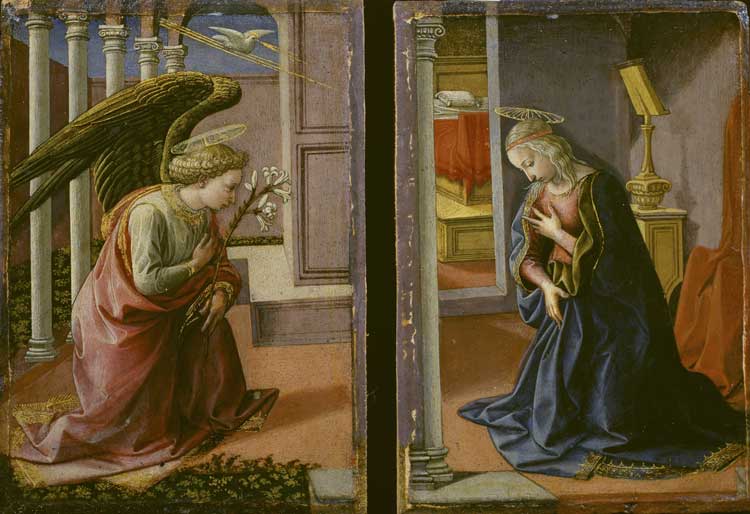
Francesco Pesellino. Diptych - Annunciation, c1450-55. Tempera on panel, 20.3 x 14.4 cm (each panel). On loan from The Courtauld, London (Samuel Courtauld Trust). Photo © The Courtauld / Bridgeman Images
The relationship between the senses and spirituality was a theological issue much discussed in Quattrocento Italy and the touch might be understood in this light. Consider his diptych of The Annunciation (c1450-53), in which the gold lines of the Holy Spirit directed at Mary’s heart – to indicate the touchless incarnation of Christ – are visible in Gabriel’s panel but not in hers. The two-panelled format is cleverly used to create a division between the corporeal and spiritual realms: Mary gazes down at her midriff; she cannot see or hear the archangel, whose announcement she knows but does not sense.
We might also consider the two pictures (c1442-45) that were originally part of the predella, or base, of the Novitiate Altarpiece, the main component of which was painted by Pesellino’s elder collaborator, Fra Filippo Lippi (c1406-69). The first shows Saint Francis receiving the stigmata, with an angel-winged Christ emitting gold beams from his hands and feet to the saint’s hands and feet. This is both touch and not touch. The lines of paint physically join Christ to the saint and the informed viewer can imagine the holes they will leave. But these lines are also metaphors for something intangible. The neighbouring image shows another intervention on the human body. The doctor twins, Saints Cosmas and Damian, replace a white man’s “cancerous” leg with that of a deceased Ethiopian (the art historian Scott Nethersole has argued that, before the transatlantic slave trade, 15th-century Florentines would probably have been more concerned about whether the “donor” of the limb was Christian than the difference in skin colour). Again, the surgery is touch, but its success is deemed a miracle; it is spirit that binds the body to the new limb.
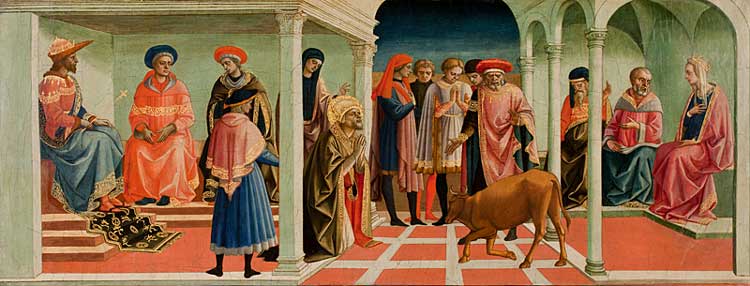
Francesco Pesellino. A Miracle of Saint Silvester. Tempera on panel, 31 x 78 cm. Worcester Art Museum, Worcester, MA. © Worcester Art Museum / Bridgeman Images.
One of the most affecting qualities of Pesellino’s work is his purposeful use of painting’s stillness and silence, something even felt in the maximalist David panels, in the quiet resolve on the hero’s face, offset by the hubbub. Painting is, generally if not definitively, a still and silent medium, but Pesellino embraces these inherent properties, not to defy them illusionistically, but to render almost-sounds and almost-movements that hint at what cannot be sensed. Over and above iconography, it is this particular restraint that conjures ineffability. It is felt in Mary’s hands (in The Annunciation and the Virgin and Child), touching and almost-touching, and notably in the communication, the nods and looks, between figures in A Miracle of Saint Silvester (c1450-53). Here, at first, one might think the bull is kneeling in deference before the saint who resurrects him and, in a way, perhaps, he is. The movement is bidirectional, honouring the validity of the miracle while also demonstrating it. The whole scene is held together by in-betweenness, a feel for the gaps. It is a conscious holding back. It opens a space for a dimension of which the sensory world is only an equivalent. True, the space is sensed, but it may be the closest thing shy of abstraction to acknowledging that the deeper realities cannot be.
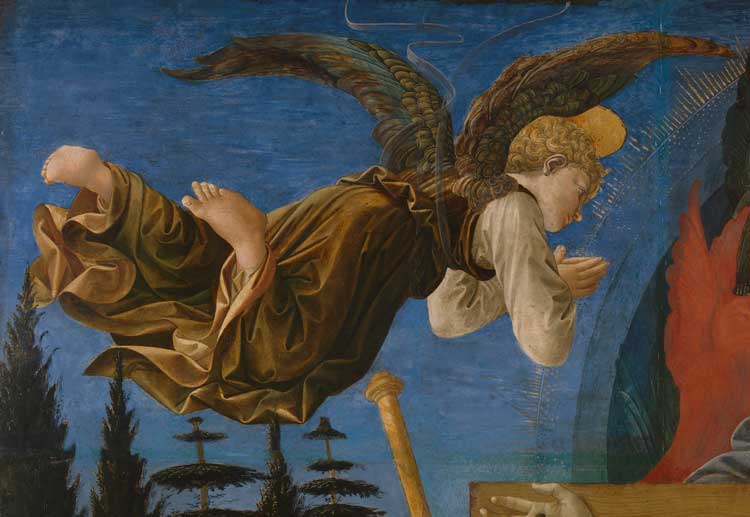
Francesco Pesellino, Fra Filippo Lippo and Workshop. Angel (Left Hand), 1455-60. Egg tempera, tempera grassa and oil on wood, 43.5 × 61.5 cm. © The National Gallery, London.